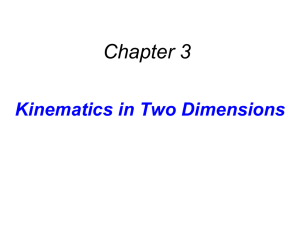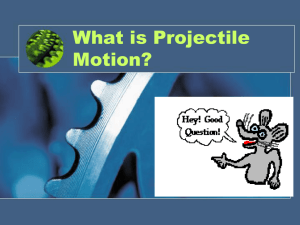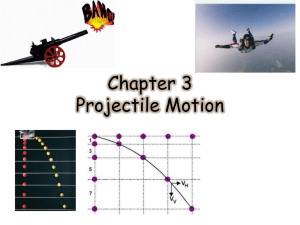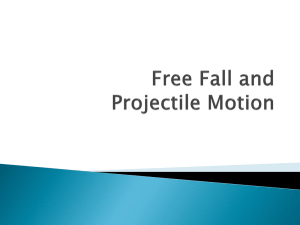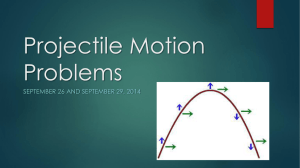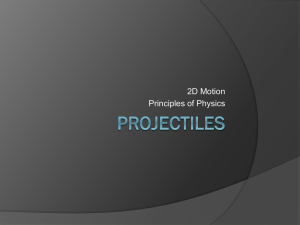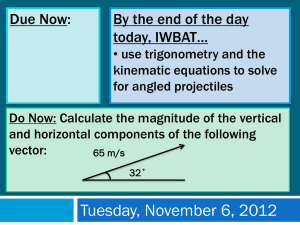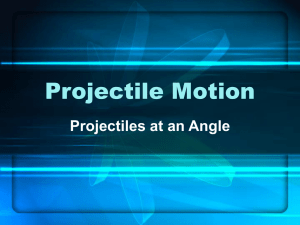CH10 – Projectile and Satellite Motion
advertisement
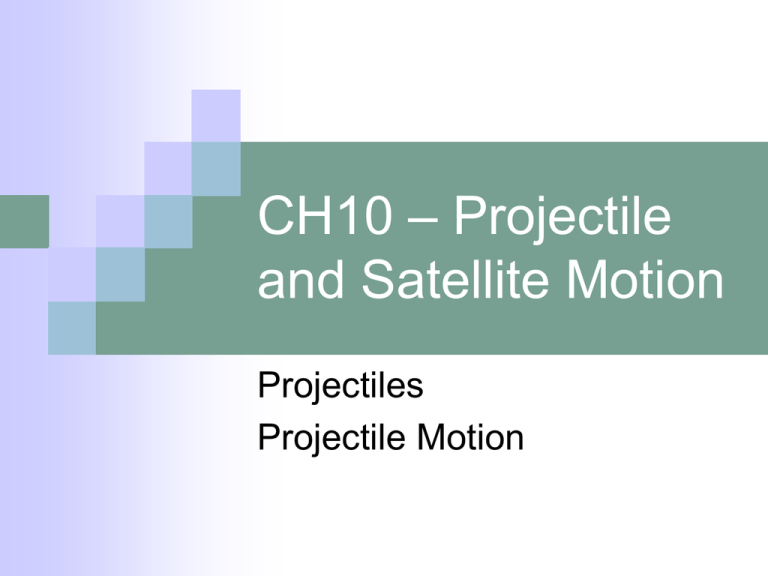
CH10 – Projectile and Satellite Motion Projectiles Projectile Motion Motion Revisited… Horizontal Motion Speed or Velocity or velocity = distance time v = d / t Speed Acceleration Acceleration a = velocity time =v/t A ball rolling horizontally… Moves friction at a constant speed if we neglect Motion Revisited… Vertical Motion Velocity v Distance d = ½ gt2 Time = gt t 2d g Falling ball Falls at a constant acceleration if we neglect air resistance Projectile Motion A projectile is an object moving only under the influence of gravity. No other forces are involved, other than an initial push, hit, throw, launch, shoot, etc. The horizontal motion is independent of the vertical motion. Projectiles have parabolic path. Projectile Motion Projectile Motion is a combination of horizontal and vertical motion. Two types of projectiles: Horizontal Upward Projectile Motion – Horizontal Horizontal Projectiles— Initial velocity is only horizontal, then fall begins (acceleration down) but horizontal velocity does not change. Projectile Motion – Horizontal Horizontal (x) direction Initial velocity only in this direction No acceleration Final velocity = initial velocity since no acceleration vx = d / t Vertical (y) direction No initial velocity Acceleration due to gravity (9.8 m/s) Final velocity depends on time in air vy = gt Projectile Motion – Horizontal At the instant a horizontally held rifle is fired over a lever range, a bullet held at the side of the rifle is released and drops to the ground. Which bullet, the one fired downrange or the one dropped from rest, strikes the ground first? They strike the ground at the same time! Projectile Motion – Upward Upward Projectiles— Initial velocity is at some angle upward, above horizontal. Acceleration is down. Horizontal velocity is constant. Range is the horizontal distance traveled. Projectile Motion – Upward Horizontal (x) direction Initial velocity in this direction No acceleration Final velocity = initial velocity since no acceleration vx = d / t Vertical (y) direction Initial velocity also in this direction Acceleration due to gravity (9.8 m/s2) Final velocity depends on time in air vy = gt Projectile Motion – Upward Launch angles… If the launch speed is the same but the launch angles are different, the projectiles will have the same range if (launch angle 1 + launch angle 2 = 90o) Maximum Range at 45o Projectile Motion – Upward Example The boy on the tower throws a ball 20 m downrange as shown below. What is his pitching speed? Questions about Projectile Motion 1. Why does the vertical component of velocity for a projectile change with time, whereas the horizontal component doesn’t? 2. A rock is thrown upward at an angle. What happens to the vertical component of its velocity (A) as it rises? (B) as it falls? 3. A projectile falls beneath the straight-line path it would follow if there were no gravity. How many meters does it fall below this line if it has been traveling (A) for 1 s? (B) for 2s?
